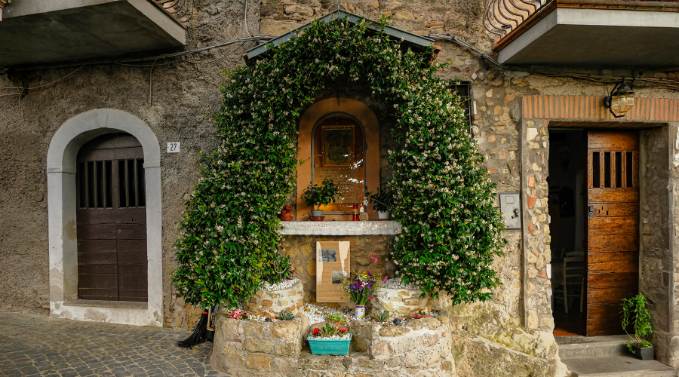Paliano - Città Fortezza Edicola della Santissima Trinità

Italiano
L'audioguida è alla fine dell'articolo
È uno dei “luoghi della memoria” per la comunità palianese, legata ad un evento che avrebbe potuto essere una catastrofe e che invece si risolse senza spargimento di sangue. Nella notte tra il 3 e il 4 giugno 1944, durante la ritirata dei Tedeschi, incalzati dagli Alleati, un bombardiere tedesco, Junkers 88, urta la sommità della torre medievale della Fortezza, perde il controllo e precipità sulle mura bruciando proprio all’ingresso di una grotta ben capiente dove si erano rifugiati centinaia di Palianesi per sfuggire ai bombardamenti.
Era la grotta alla Bellavista, così chiamata per lo splendido panorama che vi si gode affacciandosi alle mura e che, di notte, fa assomigliare la vallata prenestina e i paesi sugli Ernici ad un grande presepe.
La scelta di rifugiarsi in questa lunga e robusta grotta venne dettata dalla consapevolezza che essa aveva un’altra uscita che dava su via Zancati, per cui era considerata “sicura” tanto che nessuno vi perì nonostante il terrore, i pianti, le urla.
Il giorno dopo, il 4 giugno, ricorreva la festa della Santissima Trinità e tutti gridarono al miracolo operato dalle Tre Persone. Venne quindi costruita un’edicola con targa in ricordo e un modellino dell’aereo. Da allora riprese con fervore il pellegrinaggio a Vallepietra per ringraziare del miracolo.
Una nota di speranza e di vita, che continua anche nella disperazione: in mezzo al terrore della guerra quella notte, in quella grotta, in mezzo ad una folla terrorizzata, una donna partorì. Era nata Rosaria, così chiamata a ricordo del rosario che si recitava.
English
The audio guide is at the end of the article
It is one of the “places of memory” for the community of Paliano, linked to an event that could have ended in catastrophe but instead concluded without bloodshed. On the night between 3 and 4 June, 1944, during the German retreat under pressure from the Allies, a German bomber, a Junkers 88, struck the top of the medieval tower of the Fortress, lost control, and crashed into the walls, catching fire right at the entrance of a large cave where hundreds of Palianese had taken refuge to escape the bombings.
It was the Bellavista Cave, named for the breathtaking view it offers from the town walls, where at night the Prenestine Valley and the villages on the Ernici Mountains resemble a vast nativity scene. The decision to take shelter in this long and sturdy cave was guided by the knowledge that it had another exit onto Via Zancati, which made it a “safe” place—so much so that no one lost their life, despite the fear, cries, and screams.
The following day, 4 June, was the feast of the Holy Trinity, and everyone proclaimed that a miracle had occurred granted by the Three Divine Persons. A shrine with a plaque and a model of the plane was built in remembrance. Since then, pilgrimages to Vallepietra resumed with renewed devotion to give thanks for the miracle. A note of hope and life that persists even in despair: amid the terror of war, that night, in that cave, in the midst of a frightened crowd, a woman gave birth. The baby girl was named Rosaria, in memory of the rosary that was being recited.
 Regione Lazio
Regione Lazio
